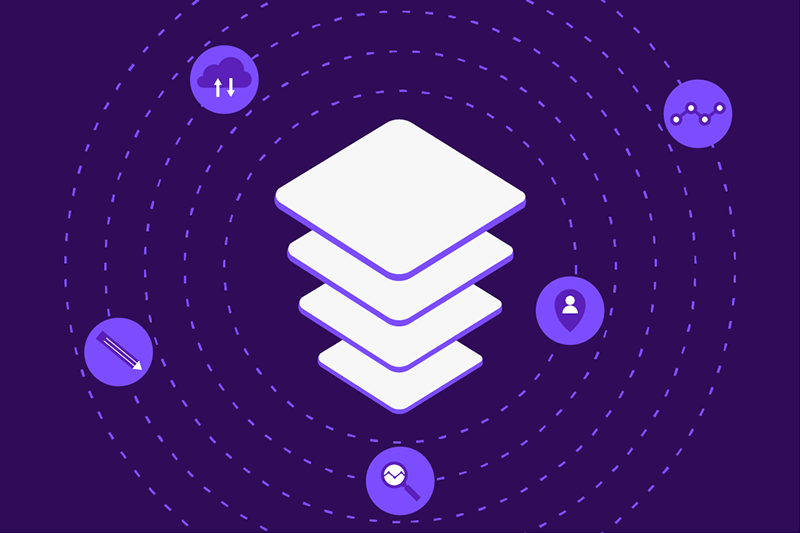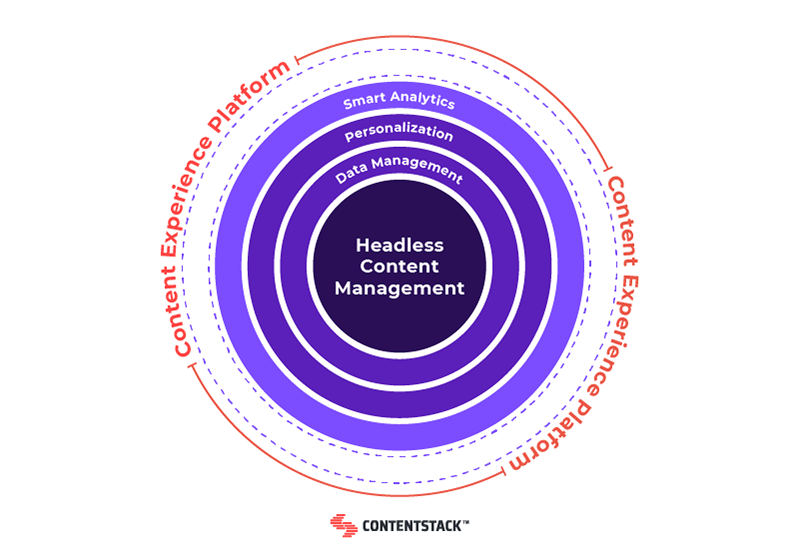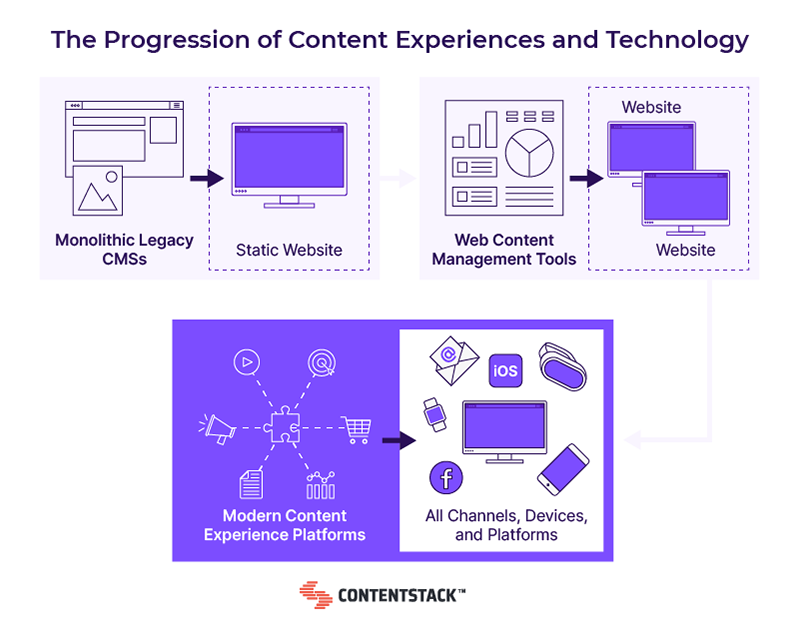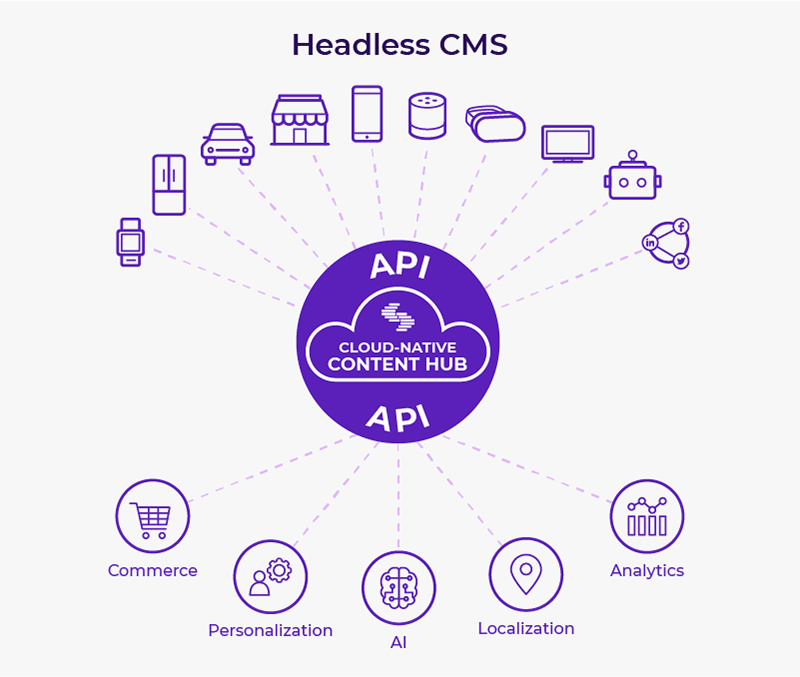From WCM to CXP: How the Content Arms Race is Killing the Legacy CMS

Struggling with how you can provide seamless customer experiences as consumers continue their conversation from chat to email to Twitter to some new app virtually unknown to anyone over 16? Wondering how you’re ever going to find the budget and coordinate the people needed to keep your content fresh and current across various local websites and growing social media channels? If these are things you’re thinking about as we’re settling into 2021, then you know it’s nothing short of a race to provide content-driven experiences that attract and engage consumers.
The good news is that today’s modern content platforms are better than the traditional content management systems (CMSs) and web content management platforms (WCMs or sometimes “WEMs”) that are still in use by many large marketing organizations. The bad news? If you’re reading this article right now, you’re probably one of those large marketing organizations using outdated software.
This article covers everything you need to know about:
- The modern content experience
- How modern content has fueled the progression from CMS to WCM to today’s CXP
- How to create a strong base for your content experience platform
What the Modern Content Experience Looks Like
It is critical to keep up in the modern content environment. The vast majority of the history of content distribution was via the same handful of predictable formats: Print, TV, and radio. Then came the World Wide Web. Nothing much changed at first — you could just put your “billboard” on a static website in addition to on the side of the road. Then, the first 3G-connected smartphone hit in the year 2000, and everything changed.
Now we can watch videos on our watches, use hand-held computers to chat with customer service reps, and order items directly to our homes with a few taps on a digital in-store kiosk.
Consumption is skyrocketing as we close in on an entire year spent in the shadow of COVID-19. A survey of 10,000 people across Europe and the U.S. found that, since the pandemic began, the average daily digital content consumption per person has risen to nearly seven hours. Over 40% of consumers said they were using connected televisions more often, 48% were on social media more frequently, and 43% were spending more time watching videos — on YouTube, specifically.
Today, readily-available mobile devices and internet connectivity have made us accustomed to consuming brand content and, often, making purchases anytime and anywhere. This omnichannel delivery is bedrock of the modern content experience.
For marketers, the content experience can be more concisely defined as the sum of the interactions a consumer has with your content — ideally, as they move toward a purchasing decision. And the growing number of interactions and types of content all lead to one thing: Developing a platform for managing all of them.
What is a “Content Experience Platform”?
A content experience platform is your “control center” for all things content — content creation, management, deployment, and the various content operation tools that feed business intelligence into your content development and deployment process.
Ultimately, your CXP is where the content elements you create are empowered to become part of the modern consumer experience.
A modern content experience platform is composable because it’s built on MACH principles.
“MACH” stands for technology that is:
- Microservices-based
- API-first
- Cloud-native
- Headless
Among plenty of other benefits, what this means is that all the content experience tools you need can be individually plugged in, updated, removed, and rearranged as needed.
MACH technology is what powers the content experience platform as the central hub for data platforms, personalization software, analytical apps, and content management tools you need to create omnichannel-ready content that meets consumers where they are. This infrastructure ensures that customers have all the information they need throughout the purchasing journey.
(Check out our “Is your Enterprise Ready for MACH?” article to learn more about MACH.)

How Content Demands Have Fueled the Progression from CMS to WCM to CXP
As content and the devices upon which consumers access it continue to change, so does the technology we use to keep up with it. Here’s how the ever-quickening race to provide the most valuable content at the perfect time has led to the evolution of today’s modern content experience platform.
Traditional, Monolithic CMSs
First were traditional, monolithic content management systems. These monolithic systems are still in use by plenty of enterprises today. These legacy CMSs combine content creation with delivery, so content is permanently in its “final form” once it’s formatted for delivery to a specific channel.
While this was fine when the only device was the desktop computer and the only channel was a static website, today, it just means content that isn’t ready for omnichannel distribution.
Single-Channel Web Content Management Tools
The web content management platform (sometimes called a web “engagement” platform) came to popularity as businesses realized digital content would be a critical business capability.
WCM software helps large marketing departments bring together many of the tools they need to create, run, and analyze complex content campaigns. And while this functionality is certainly a step up from monolithic CMS platforms that are nearly impossible to integrate new features into, they’re still hyper-focused on delivering content to a single channel — the web.
Modern, Composable Content Experience Platforms
Finally, composable content experience platforms came along to provide the best of both worlds. Delivering a centralized content experience management app that plays well with outside tools, so you can create content that
genuinely
outpaces competitors in the race to deliver on omnichannel customer demands.

Building Your Content Experience Platform: It All Starts With These Four Components
Now that you know how a CXP can bring together everything you need to compete in today’s content race, it’s time to take the next big step.
While each organization’s CXP tech stack will be unique, in this section, we’ll lay out the four foundational components that will help you create your cutting-edge content experience platform.
Headless CMS
To enable its full capabilities, start your modern CXP with a MACH-based headless CMS.
Between its content capabilities and composability, a MACH headless CMS will provide the ideal foundation from which your business can create and push omnichannel content.
Why? Well, for starters, a MACH headless CMS separates the process of creating and managing content from the way that content is formatted and distributed. It uses application programming interface (API) technology to connect the front-end display layer to the back-end content repository.
The modular design means that marketing teams can create content once and reuse it for multiple platforms, using APIs to deliver the content to any device or channel, from websites and social media platforms to your customer relationship management database and beyond.
This API-driven approach also provides a flexible architecture that allows you to plug in any microservice — including best-of-breed content solutions — without expensive and time-consuming development costs.

Data Management Software
Although standard web analytics and A/B testing still have a place in a well-built marketing tech stack (think Google Analytics or Optimizely), building your CXP is all about leveling up and making it your own. Remember that the more data you can collect and use, the more value the data will generate when integrated into your CXP to inform content creation and distribution.
Link your headless CMS to a modern customer relationship management database that tracks leads through the sales funnel (such as Zendesk) and a customer data platform that supplements your customer profiles (e.g., Evergage or Bloomreach). These types of tools ensure accuracy and generate insights faster.
With this step, you’re on your way to bringing together the critical components of a modern CXP that will outpace legacy enterprise tech any day.
Personalization Tools
Personalization is a must-have in the modern CXP — especially in today’s omnichannel content environment where customers expect their experiences to be frictionless and consistent.
Personalization is all about customizing what consumers see based on their behavior and characteristics, and studies show that it pays dividends.
Research by McKinsey shows that industry leaders in personalization have increased revenue by up to 15%. Similarly, a study by Accenture found that 91% of consumers are more likely to shop with brands that recognize, remember, and provide relevant offers and recommendations.
By definition, personalization is data-driven. It requires collecting data about individual customers from various places and storing it to make it easy to analyze and take action on the findings. For brands with thousands or even millions of unique customers, it’s clear that personalization is a job for technology.
In addition to the data management tools detailed in the previous section, platforms like Hubspot and applications that tap into supercomputers like IBM Watson are a great addition to your CXP. They further support content personalization by automating everything from sentiment analysis to keyword extraction — allowing you to deliver the right message to the right customer at the right time.
Augmented and Predictive Analytics Platforms
As consumers live more of their lives online, their data footprints continue to grow. And that means there’s more data than ever before that your brand can use to generate valuable business intelligence.
The challenge of collecting, cleaning, organizing, and analyzing that data is best left to AI-driven tools that make light work of turning data into actionable insights.
Augmented and predictive analytics platforms rely on machine learning to build analytical models that will help you determine what kind of content-driven experience each consumer desires.
Augmented analytics use these models to identify patterns that human analysts would easily overlook. For example, augmented analytics can scan, evaluate, and summarize all content published on a particular topic during a specific time. So if you want to know how customers feel about your new marketing campaign — or perhaps even the campaigns that other top brands are running — augmented analytics can help you measure that.
Predictive analytics takes a similar approach to identify trends using machine learning models to determine what customers are likely to do or want next. This process can suggest actions; for example, it might recommend sending a perfectly-timed, customized email that can turn a good content experience into a great one.
With the addition of smart personalization and analytics tools to your content experience platform, you’ll be ready to run circles around your competitors with highly-personalized, omnichannel-ready content experiences.
How Will Your Business Pull Ahead in Today’s Content Race?
From legacy tech like web content management platforms to today’s MACH headless CMS, the fast pace of content has propelled marketing technology’s advancement like nothing else.
To pull ahead of the competition in the race to provide omnichannel content experiences that consumers love — it all starts with adopting the easiest to customize headless CMS: Contentstack. Request a free, no-obligation trial or demo today to see how Contentstack can support your most significant and best content goals.
About Contentstack
The Contentstack team comprises highly skilled professionals specializing in product marketing, customer acquisition and retention, and digital marketing strategy. With extensive experience holding senior positions at renowned technology companies across Fortune 500, mid-size, and start-up sectors, our team offers impactful solutions based on diverse backgrounds and extensive industry knowledge.
Contentstack is on a mission to deliver the world’s best digital experiences through a fusion of cutting-edge content management, customer data, personalization, and AI technology. Iconic brands, such as AirFrance KLM, ASICS, Burberry, Mattel, Mitsubishi, and Walmart, depend on the platform to rise above the noise in today's crowded digital markets and gain their competitive edge.
In January 2025, Contentstack proudly secured its first-ever position as a Visionary in the 2025 Gartner® Magic Quadrant™ for Digital Experience Platforms (DXP). Further solidifying its prominent standing, Contentstack was recognized as a Leader in the Forrester Research, Inc. March 2025 report, “The Forrester Wave™: Content Management Systems (CMS), Q1 2025.” Contentstack was the only pure headless provider named as a Leader in the report, which evaluated 13 top CMS providers on 19 criteria for current offering and strategy.
Follow Contentstack on LinkedIn.







.svg?format=pjpg&auto=webp)
.svg?format=pjpg&auto=webp)
.png?format=pjpg&auto=webp)






.png?format=pjpg&auto=webp)


